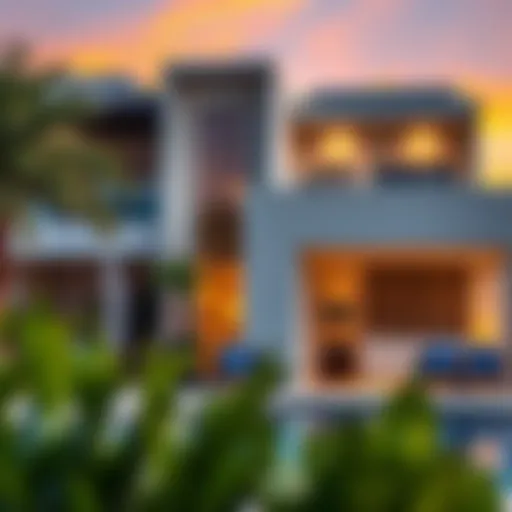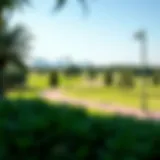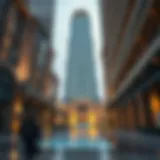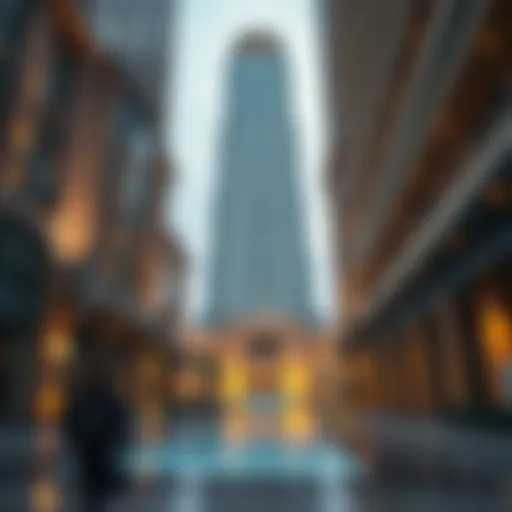The Metro Map of Dubai: A Comprehensive Guide
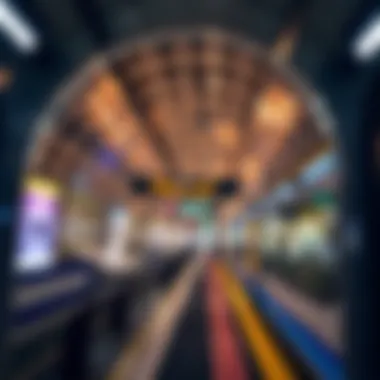

Intro
Dubai's urban landscape is a complex tapestry woven from innovative architecture, vast economic opportunities, and a world-class transportation system. At the heart of this progress lies the Dubai Metro, a sleek and efficient rail network that fundamentally reshapes how residents and visitors traverse the city. In this guide, we aim to unravel the intricate details of the metro map, its operational nuances, and its significant influence on Dubai's real estate market.
The metro isn't just a means of transport; it's a lifeline that connects diverse communities, facilitating both personal convenience and economic growth. The impact of the metro system extends far beyond its tracks, as it drives the evolution of nearby neighborhoods and influences property values. As investors and homebuyers look to make informed decisions in this dynamic market, understanding the correlation between the metro's reach and the surrounding real estate landscape becomes imperative.
By delving into the essential features of the Dubai Metro, we will explore current market trends, property insights, and the untapped potential that rests in the shadows of the metro stations. Let’s embark on this comprehensive journey through Dubai's railway marvel and unearth the opportunities that lie therein.
Prologue to Dubai's Metro System
Dubai's Metro system stands as a remarkable feat of modern engineering, transforming urban mobility in one of the world's fastest-growing cities. Since its inception, this expansive transit network has not just made traveling more convenient for everyday commuters, but it's also reshaping the fabric of the city itself.
One cannot underestimate the financial and social impacts brought about by the metro system. With over 75 kilometers of track, it serves as a vital artery for millions of residents and tourists alike, linking key commercial, residential, and entertainment hubs. The efficiency of this transport option encourages people to leave their cars at home, thus promoting a more sustainable urban lifestyle. Moreover, as we peel back the layers of this transit system, it becomes clear that navigating the metro isn't merely a means of getting from point A to point B; it holds significant implications for real estate development and market trends in Dubai's dynamic landscape.
Historical Context
The conception of Dubai's Metro dates back to the early 2000s, driven by a growing population and the need for streamlined urban transport. The city witnessed a rapid increase in inhabitants, largely attributed to its burgeoning economy and status as a global hub for business and tourism. As population pressures mounted, the vision for a convenient and efficient metro system took shape, resulting in the launch of the Red Line in 2010, followed shortly by the Green Line.
By choosing to build a driverless metro system, Dubai positioned itself as a leader in futuristic transport solutions. Today, it encompasses more than just transportation; it's an emblem of Dubai's ambition and innovation. This system was not born overnight; rather, it represents years of strategic planning, complex engineering, and a clear commitment to improving the quality of life for its citizens and tourists.
Significance in Urban Planning
In urban planning circles, the integration of the metro into Dubai’s public transport scheme reflects forward-thinking and strategic allocation of resources. The metro lines significantly ease congestion on the city’s roads, providing a high-speed alternative for daily commuters. Each metro station envelopes potential as a contributing factor to local economies.
Real estate developers are increasingly aligning projects with proximity to metro stations, knowing well that properties near these transit nodes tend to appreciate faster. As such, the metro's presence has translated into areas of investment opportunities, reshuffling the real estate landscape entirely. Properties near major stations are not merely seen as residential or commercial; they are perceived as integral parts of a larger urban ecosystem.
"Dubai's Metro system is more than a transit solution; it's a catalyst for real estate development and economic opportunity."
In light of these evolving dynamics, the success and efficiency of the metro network serves as a benchmark for other megacities aiming to enhance their transportation systems. As Dubai continues to expand its metro offerings, future developments promise to cater to a growing populace while also keeping an eye on sustainability and economic growth. Understanding these facets is essential for investors and stakeholders alike.
Overview of the Metro Map
The metro map of Dubai serves as not just a guide for commuters, but a blueprint of the city’s ambitions and a lifeline for its residents and visitors alike. Understanding the metro layout is crucial for anyone navigating the bustling urban environment, particularly those eyeing property investments. A well-structured metro system enhances accessibility, connecting key neighborhoods and commercial areas, which in turn directly influences real estate trends. By analyzing the metro map, prospective buyers and investors can assess which stations are closer to vital services and amenities, significantly impacting property values.
Key Features of the Map
One glance at the metro map reveals a sophisticated design built for efficiency and ease of use. There are a few pivotal characteristics to note:
- Color Coded Lines: Each line on the metro map is distinctly colored, making it easy for travelers to distinguish their route at a mere look. For instance, the Red Line stretches across the city’s heart, while the Green Line complements it by facilitating north-south travel.
- Interchange Stations: Certain stations act as key junctions, where lines converge enabling seamless transfers. Stations like Union and Burjuman serve as transport hubs that significantly improve connectivity for passengers.
- Landmarks and Facilities: The map identifies various landmark destinations, such as shopping malls, parks, and hospitals. This feature is particularly useful for investors to visualize not just the transportation routes, but also the lifestyle and services available near their potential properties.
By understanding these key features of the metro map, individuals can not only plan their journey but also gauge the economic footprint of different areas around the stations.
Lines and Their Color Codes
The Dubai Metro encompasses multiple lines, each with its own defined color code, thus simplifying the navigation process. The most essential lines include:
- Red Line (Line 1): Represented in red, it spans from Rashidiya to UAE Exchange, covering major attractions like Dubai Mall and Burj Khalifa.
- Green Line (Line 2): Shown in green, it runs from Etisalat to Dubai Creek, linking key areas with a focus on residential neighborhoods.
- Future Black Line (Line 3): While currently in planning stages, it promises to enhance connectivity even further across new districts, with an envisioned black line in the map schematic.
These color codes not only ease the commuter experience but also situate the stations in a broader context of urban development, giving investors a clearer view of evolving hotspots as the city continues to expand.
"The Dubai Metro is more than just travel; it’s a shift in how people envision the future of urban living."
In essence, the overview of the metro map acts as a vital tool for navigating both the physical landscape and the real estate opportunities inherent within it. Investors looking to expand their portfolio or homebuyers seeking properties that promise both comfort and convenience find immense value in understanding these connections.
Detailed Analysis of Metro Lines
Understanding the detailed workings of Dubai's metro lines is crucial for a couple of reasons. Foremost, the subway system, like a well-played chess match, is pivotal to grasping not just transportation in Dubai but also the broader urban planning strategies that fuel the city's explosive growth. Each metro line connects significant districts and areas, fostering real estate development and accessibility. Exploring these lines reveals the undercurrents that shape Dubai's real estate market, making it indispensable for investors and home-seekers alike.
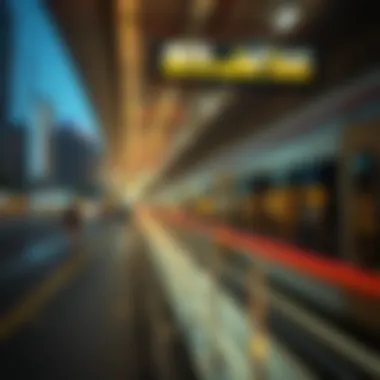

Red Line
Key Stations
The Red Line, extending from Rashidiya to UAE Exchange, serves as a lifeline for commuters, linking key landmarks like Dubai Mall and Burj Khalifa. One of the standout features of the Red Line is its sheer coverage. The stations are strategically placed to provide access to major commercial hotspots, turning them into go-to spots for those looking to jumpstart their day.
One noteworthy aspect of these key stations is the integration of various amenities—many of them are adorned with shopping outlets and eateries, essentially turning transit into a lifestyle experience. This thoroughfare is not only a means to get from point A to point B; it’s a neighborhood capsule, reflecting the busy rhythm of city life.
Surrounding Neighborhoods
The neighborhoods surrounding the Red Line are alight with activity; they range from high-end residential complexes to bustling markets. Jumeirah Lakes Towers stands out with its vibrant community feel, embodied by cafés and parks that beckon after a long day at work. The eclectic mix caters to various demographics, each adding to the district's character.
However, one ought to consider the trade-offs. High demand zones come with escalated property prices, acting as a barrier for some potential buyers. But on the flip side, this also translates into a potentially lucrative investment opportunity given the steady influx of new residents and business ventures supporting this lively ecosystem.
Real Estate Insights
The Red Line's importance in the real estate landscape is hard to overlook. Proximity to the stations significantly boosts property values, making them a sweet spot for investors. Properties around top stations have seen notable price appreciation, thus indicating a growing desirability among buyers.
Investors may note that the strategic connections to commercial hubs and cultural attractions make these properties a desirable pick, enhancing their allure. But all that glitters isn’t gold; competition can be steep, often leading to potential buyers needing to act fast to secure deals in these prime locations.
Green Line
Key Stations
The Green Line, extending from Etisalat to Dubai Creek, may not be as long as the Red Line, but it packs quite a punch with stations that bring both residential and business opportunities. Al Ghubaiba Station, for instance, is a gem—interconnected with the bus system and offering quick access to the historic Dubai Creek, bridging modernity with heritage.
Such strategic positioning means that these stations don’t just serve a functional purpose; they act as cultural conduits, providing access to diverse experiences. Commuters aren't merely traveling; they're part of a broader narrative that connects neighborhoods, cultures, and economic activities.
Surrounding Neighborhoods
Areas like Deira and Bur Dubai around the Green Line are rich in history, boasting markets and a beautifully woven tapestry of cultures. Properties here offer unique characteristics, often attracting buyers who lean towards a vibrant lifestyle over pristine new builds.
While this mix of old and new is appealing, navigating the real estate market in these neighborhoods requires diligence. Prices may be more favorable than in newer developments, but one must pay close attention to property conditions and regulations in place—making due diligence crucial.
Market Trends
As for market trends associated with the Green Line, the growth rate for properties here has shown promise. While perhaps not as steep as the Red Line’s rise, values in the Green Line neighborhoods are ticking up as more amenities get introduced and global attention turns its gaze toward these culturally-rich areas.
The soft underbelly? Investors need to consider the potential for market fluctuations attributed to external economic factors. Despite that, being educated on the shift in developing areas alongside the Green Line can yield dividends for those already in the loop.
Blue Line Plans
Future Developments
Though still labeled as plans, the proposed Blue Line promises to be a game changer in the upcoming years. Connective routes through areas like Dubai Marina and Al Quoz are replete with anticipation of not only improved transportation but also a surge in local development.
What makes the concept of the Blue Line so appealing? It resonates with the need for future urban growth strategies, hinging on the principle that efficient transport correlates with significant urban development. This foresight makes it a favorable choice for savvy investors keeping an eye on emerging trends.
Projected Impact on Real Estate
When the Blue Line materializes, its projected impact on real estate will likely ripple throughout Dubai. Connecting peripheral areas to existing metro lines opens up previously affordable options to those who work in central hubs, subsequently boosting demand for properties along these new routes.
Investors should keenly observe how initial interest translates into actual property transactions and price changes, especially as development progresses. However, with hope comes caution—early expectations should be tempered with realistic projections based on market dynamics.
"The future of the metro doesn’t just lie in transit; it’s tied into the heart of how real estate evolves in Dubai."
In summary, the detailed analysis of metro lines sheds light on real estate trends across Dubai, making it essential for any entity looking to invest or relocate within this vibrant metropolis.
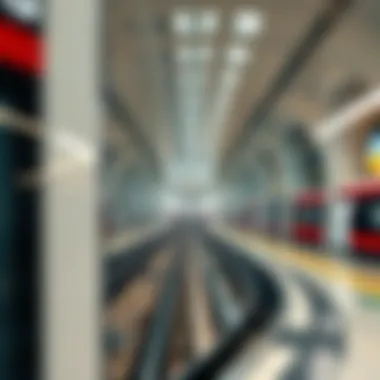

Metro Station Highlights
The metro stations throughout Dubai serve as more than transit points; they are embedded in the very fabric of urban life. These hubs stand as gateways to the city, showcasing a fusion of architectural innovation and functional design. Many travelers rely on this modern transit solution, making it a backbone of both everyday commuting and occasional sightseeing. At the same time, understanding the unique aspects of various metro stations can provide valuable insights for investors and homebuyers aiming to capitalize on the booming real estate landscape surrounding these sites.
Highlighting the stations is crucial for several reasons. First, it is about emphasizing the strategic locations that these stations occupy. Proximity to a metro station can enhance property values. Next, these stations often come with various amenities and services, catering to both residents and visitors alike, thus increasing foot traffic and local business exposure. Lastly, by examining the characteristics and significance of each station, stakeholders can glean the economic potential associated with them.
Landmark Stations
Landmark stations are often more than just stops; they can become symbols of the city itself. One such example is the Burj Khalifa/Dubai Mall Station. This station, directly underneath the world's tallest building, acts as a major draw for tourists and locals. The surrounding area features luxury shopping, fine dining, and spectacular views, elevating its status as a prime investment zone.
Another noteworthy station is Union Station, a key interchange for both the Red and Green Lines. This station connects multiple neighborhoods and commercial districts, making it an ideal area for businesses. Moreover, it often sees high passenger traffic due to its central location, further enhancing its real estate appeal.
Key characteristics of these landmark stations include:
- Architectural Design: The aesthetics draw a crowd and add to the overall experience
- Accessibility: Easier access to major attractions or residential areas can drive more foot traffic
- Amenities: Quality of surrounding services, from cafes to convenience stores, enhances daily life
Understanding why these stations are significant to the city's culture and economy can empower bespoke investment decisions.
Stations with Real Estate Opportunities
When investors look to maximize returns, proximity to metro stations is a crucial factor. Certain stations, like Dubai Marina Station and Jumeirah Lake Towers Station, stand out not just for their connectivity but also for the real estate opportunities they present. Listings around these areas have seen growth due to the attractive living conditions offered by the waterfront and community amenities.
Additionally, stations in rapidly developing areas such as Dubai World Trade Centre Station have plenty of potential. Here, the surrounding neighborhoods are rapidly evolving, and new developments are sprouting up that cater to growing demand for living spaces.
Some considerations when evaluating stations for investment include:
- Current Market Trends: Analyze the real estate trends surrounding the stations
- Future Developments: Keep an eye out for planned projects that may enhance property desirability
- Community amenities: Proximity to schools, parks, and commercial areas adds value to properties
"Investing near metro stations opens a door to untapped potential in a thriving metropolis like Dubai."
By focusing on these stations, investors can better position themselves to make informed choices, capitalizing on the city’s rapid development and ensuring lucrative returns.
Impact of the Metro on Dubai's Real Estate Market
The Dubai Metro, a marvel of modern urban planning, has reshaped not only how residents and visitors navigate the city but also the very landscape of the real estate market. Its significance transcends mere transportation; it lays a foundation for residential and commercial development in areas adjacent to its routes. The impact of the metro on Dubai's real estate market intertwines closely with property value trends and investment opportunities, making it a crucial consideration for anyone eyeing property in this dynamic city.
In essence, the metro acts as a catalyst for growth. Accessibility is a major player in property valuation. With strategically placed metro stations, you might find neighborhoods that were previously modestly priced start to command substantial premiums. Investors keen on maximizing returns must grasp this fundamentally - the proximity to metro stations often dictates the desirability of a property.
Moreover, understanding the socio-economic implications of the metro’s influence helps in demystifying its impact on real estate. Cities evolve, and the areas around transit hubs are brimming with potential for commercial ventures and residential hotspots. Having this foresight can place savvy investors ahead of the pack.
"For every major metro line extended, property values around its stations soar, making it crucial for investors to keep a keen eye on such developments."
Property Value Trends
Examining property value trends in the vicinity of metro stations is insightful. Typically, we observe that properties located within a kilometer of a metro station experience a noteworthy surge in value. Take, for instance, stations like Burjuman and Deira City Centre on the Red Line; they’re now prime spots for both rental yields and capital appreciation.
- Recent statistics from local real estate research indicate:
- Properties within a 500-meter radius of a metro station have appreciated by approximately 20% over the last few years.
- Rental demand has also spiked, with average rents climbing almost 15% in some neighborhoods due to enhanced accessibility.
The shift toward metro-friendly living is a testament to urban migration patterns as residents seek convenience in navigating daily commutes. Families, working professionals, and even students are favoring homes near metro lines. Hence, those looking to invest should closely monitor these evolving trends, highlighting neighborhoods poised for further development.
Investment Opportunities
For investors, the Dubai Metro isn't just about convenience; it signals budding opportunities worth capitalizing on. As the metro expands, new projects and commercial zones sprout along its corridors.
- Key areas to watch include:
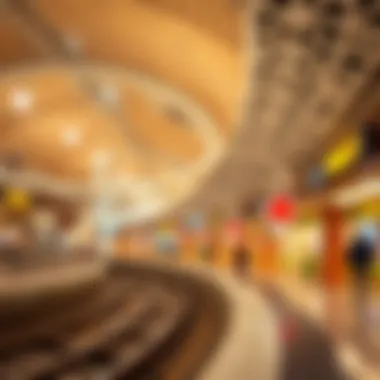

- Dubai Marina: Improvements in metro connectivity here are attracting young professionals and expatriates looking for rental properties.
- Business Bay: An emerging hub where commercial and luxury residential developments are thriving, supported significantly by accessibility.
The current landscape hints at a trend where investments in properties near metro stations yield favorable returns. Developers are increasingly interested in launching projects that cater to both residential and mixed-use demands, all underpinned by the essential access provided by the metro. These pockets of investment present a dual opportunity—capital growth and rental yield.
Navigating the Metro System
The intricate web of Dubai's Metro system is not merely a mode of transportation but a gateway to understanding the city's urban fabric. Navigating this system efficiently can greatly enhance your experience, whether you're a visitor, a potential resident, or an investor delving into the vibrant property market. Understanding the key aspects of the metro system, primarily ticketing and operational details, will empower you to maximize your journey through one of the most expansive and modern transit networks in the world.
Ticketing and Fares
Using the Dubai Metro is a straightforward process, thanks to its well-structured ticketing system. The first step is to familiarize yourself with the different types of tickets and payment methods available. Here’s a breakdown of what you need to know:
- Nol Card: The Nol card is your best friend. It’s a smart card that can be used not only on the metro but also on buses and water taxis. There are different types of Nol cards—red for tourists, and blue, silver, and gold for residents—with benefits varying by type.
- Single Journey Ticket: If you’re planning a quick trip, this option allows travel between two metro stations for a limited fare. It’s a good choice for those not planning to use the metro frequently.
- Daily, Weekly, and Monthly Passes: For regular users, these passes offer savings. A daily pass allows unlimited travel within 24 hours, while weekly and monthly passes smooth out travel for those staying longer.
- Discounts: Students, senior citizens, and people with disabilities may be eligible for fare reductions, so be sure to present the appropriate ID when purchasing your ticket.
The use of Nol cards is not just a convenience; it’s an illustration of Dubai’s push towards a cashless economy.
Understanding fares is crucial as it is based on the distance travelled. In the metro system, fares range from AED 3 to AED 7.5 depending on the zones traversed. Hence, if your plans involve hopping across multiple stops, do keep an eye on your route to avoid any unexpected increases in fare.
Operational Hours and Frequency
The operational hours of the metro align well with the fast-paced lifestyle of Dubai residents and visitors. Generally, the metro runs from 5 AM to midnight, with extended hours on weekends and public holidays. Knowing the operational hours is essential for effective planning:
- Weekdays: The metro operates from 5 AM until midnight. This schedule accommodates early commuters and late-night travelers alike.
- Weekends and Holidays: On Fridays and Saturdays, the metro services are extended up to 1 AM. This is particularly beneficial for social events or late-night outings.
- Frequency: Trains arrive every 2 to 5 minutes, depending on the time of day and line. Peak hours see trains arriving at the shorter end of that interval, while off-peak hours might see slightly longer waits.
Understanding these elements of Dubai’s Metro system will not only facilitate smoother travel but also paint a clearer picture of the connectivity integral to exploring potential real estate markets in the vicinity of metro stations.
The Future of Metro Expansion
The expansion of Dubai's metro system isn't just about adding new tracks and stations; it represents a broader vision for the city's future. As Dubai continues to grow, the metro system needs to adapt to the ever-increasing demand for efficient public transport. Beyond providing convenience, it plays a pivotal role in shaping urban landscapes, influencing real estate markets, and enhancing the overall quality of life for residents and visitors alike.
Upcoming Projects
Several exciting projects are on the horizon for the metro system. These projects aren't just about extending the railway network; they focus on improving connectivity and enhancing accessibility:
- Route 2020: This extension of the Red Line connects the metro to Dubai Expo 2020, showcasing the city’s push to integrate major events into public transport.
- Integration with other transport modes: Upcoming projects aim to link the metro with new tram networks and bus systems, creating seamless transfers for passengers.
- New Stations: Stations like the Dubai Investment Park and the Dubai World Central Airport station are under discussion, which will tap into emerging residential and business hubs.
The integration of these projects highlights a commitment to enhancing public mobility while supporting economic growth. Such initiatives not only improve daily commuting times but also encourage investment prospects in adjacent areas.
Long-Term Vision
Looking further down the track, Dubai's long-term vision for the metro involves a commitment to sustainability and technology. This vision aims to position the metro system as a model for future urban transit solutions:
- Sustainability Initiatives: Plans to introduce energy-efficient technologies and environmentally friendly vehicles are a critical focus, aligning with global trends promoting green alternatives in urban transport.
- Passenger Experience: Innovations will enhance user experience, including advanced real-time tracking and mobile connectivity.
- Smart Stations: Proposals for smart stations equipped with the latest technology could revolutionize how commuters interact with the system, potentially incorporating augmented reality for navigation and real-time updates.
This proactive approach showcases Dubai’s ambition to create a public transit system that supports not just the present needs but also anticipates future demands, ensuring it remains competitive on the global stage.
Ending
In the grand tapestry of Dubai's urban landscape, the metro system emerges as a crucial thread binding together neighborhoods, commerce, and community. This article has navigated through various facets of the Dubai Metro, revealing its structure, operational features, and how it underpins the city’s real estate dynamics. Understanding the significance of the metro map is not only for daily commuters but holds unprecedented importance for investors and real estate professionals alike.
Summary of Key Points
The metro system in Dubai drastically alters the urban experience. Key points relayed in this guide include:
- History and Development: The metro's inception reflects the city's rapid urbanization since the early 2000s, aimed at alleviating congestion and enhancing mobility.
- Metro Map Features: From color-coded lines to key stations, the map serves not merely as a navigational tool but also as a visual representation of Dubai’s expansion and connectivity.
- Impact on Real Estate: Certain metro stations have become nuclei of real estate activity, influencing property prices and attracting investment.
The interplay of these factors illustrates how the metro not only facilitates movement but also stimulates economic growth, making it an essential component of urban planning.
Implications for Real Estate Investors
For investors, understanding the connections between the metro system and real estate trends is critical. Here are a few implications to consider:
- Location, Location, Location: Properties near metro stations often experience augmented demand due to their accessibility. This leads to potential increases in property value, making them an attractive investment.
- Future Developments: Investing in areas earmarked for future metro expansions could yield remarkable returns once those developments materialize, as they can enhance the attractiveness of previously undervalued areas.
- Market Trends Awareness: Keeping an eye on shifts in metro traffic and ridership patterns can be a sage strategy for entering or exiting markets. A spike in usage might correlate with neighborhood revitalization, indicating an opportune time to invest.









